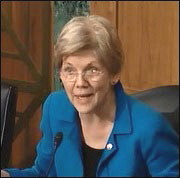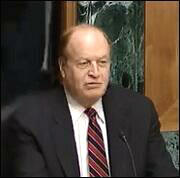By Pam Martens and Russ Martens: March 4, 2015

Senator Elizabeth Warren Questions Panel Members at the March 3, 2015 Hearing on Fed Accountability and Reform
Yesterday, the Senate Banking Committee held the first of its hearings on widespread demands to reform the Federal Reserve to make it more transparent and accountable.
Senator Elizabeth Warren put her finger on the pulse of the growing public outrage over how the Federal Reserve conducts much of its operations in secret and appears to frequently succumb to the desires of Wall Street to the detriment of the public interest. Warren addressed the secret loans that the Fed made to Wall Street during the financial crisis as follows:
“During the financial crisis, Congress bailed out the big banks with hundreds of billions of dollars in taxpayer money; and that’s a lot of money. But the biggest money for the biggest banks was never voted on by Congress. Instead, between 2007 and 2009, the Fed provided over $13 trillion in emergency lending to just a handful of large financial institutions. That’s nearly 20 times the amount authorized in the TARP bailout.
“Now, let’s be clear, those Fed loans were a bailout too. Nearly all the money went to too-big-to-fail institutions. For example, in one emergency lending program, the Fed put out $9 trillion and over two-thirds of the money went to just three institutions: Citigroup, Morgan Stanley and Merrill Lynch.
“Those loans were made available at rock bottom interest rates – in many cases under 1 percent. And the loans could be continuously rolled over so they were effectively available for an average of about two years.”
One of the key reasons that the Fed wanted to keep this information buried from the public is that Citigroup was insolvent during the period it was receiving loans from the Fed.
There is also growing distrust of how some Fed personnel appear to cozy up to Wall Street. During Federal Reserve Chair Janet Yellen’s appearance before the Senate Banking Committee a week earlier, Senator Warren severely criticized the actions of Scott Alvarez, the General Counsel of the Federal Reserve. Warren said Alvarez had delivered a speech before the American Bar Association challenging Dodd-Frank’s so-called push-out rule that would bar insured depository banks from holding dangerous derivatives and swaps on their books. Not long thereafter, Citigroup slipped a repeal of the provision into the must-pass spending bill that would keep the government running through this September.
Warren noted that the Dodd-Frank legislation was passed in 2010 but the Fed had stalled the implementation of the push-out rule until 2016 – long enough for Citigroup to eventually have it repealed, a feat which it has now accomplished.
Warren also revealed that Alvarez was stonewalling her office in making his findings public on his investigation into a leak of information from a September 2012 Federal Open Market Committee (FOMC) meeting. The Senator noted that Wall Street firms can make significant profits trading on leaked FOMC information ahead of public disclosure. Warren said the public was still waiting two and a half years later for Alvarez to disclose the details of what occurred.
One of the four panelists at the hearing, Peter Conti-Brown, an Academic Fellow at Stanford Law School whose forthcoming book, The Power and Independence of the Federal Reserve, will be published by Princeton University Press, also weighed in on the Fed’s General Counsel. Conti-Brown said in his written statement:
“…while other general counsels at administrative agencies are not subject to presidential appointment, the Fed’s chief lawyer makes judgments of extraordinary importance that are unlikely to ever be subject to judicial review. Courts have made clear for eighty years that they will not review the Fed’s decision about monetary policy, including when those decisions require novel interpretations of law. And in the crisis, emergency decisions were made that have been effectively removed from judicial review, including violations of state corporate law and issues raised by the Constitution. While judicial review still occurs in many of the Fed’s regulatory determinations, in places where value judgments are of the most consequence, the Fed’s lawyer is the first and last word on what the law allows or forbids. For this reason, the Fed’s chief lawyer should be a presidential appointment…”
Given the public’s disgust with President Obama’s Wall Street appointments, this hardly seems like a solution that will curry favor with the citizenry. A far more pragmatic solution would be to strip the Fed of any regulatory role and let it get back to its Congressional mandate of setting monetary policy.
In answer to a question on regulatory capture at the Federal Reserve banks, Conti-Brown said “the very idea that bankers are selecting their regulator – not through Congress but directly through the exercise of vote should give us all pause…How could the Reserve Bank presidents do anything but dance with the one that brung them.” (Dodd-Frank eliminated the ability of Class A Directors which consist of banking interests to vote on the selection of the regional Fed Bank Presidents. However, Class A Directors elect three Class B Directors who do get to vote on the selection of the Bank President along with Class C Directors who are chosen by the Federal Reserve Board of Governors.)

Senator Richard Shelby Delivering His Opening Statement at the Senate Banking Hearing on Fed Accountability and Reform
One area of complete agreement among the four panelists at the hearing is that the New York Fed has far too much power and it must be reined in. Senator Richard Shelby, Chair of the Senate Banking Committee, quoted a passage from a recent speech delivered by retiring President of the Dallas Fed, Richard Fisher. Shelby said Fisher had stated that “too much power is concentrated in the New York Fed.”
Paul Kupiec of the conservative American Enterprise Institute who appeared on the panel said that moving the market desk from the New York Fed across other regional Fed banks would help to diversify the New York power base. Conti-Brown said that anything that would deemphasize the influence of the financial institutions in New York would be good. The other two panelists, Allan Meltzer, Professor of Political Economy at the Tepper School of Business at Carnegie Mellon and John Taylor, Economics Professor at Stanford University, agreed with the assessment that the New York Fed has too much power.
The full written testimony of the panelists can be accessed below.
- Dr. John B. Taylor [view testimony]
Mary and Robert Raymond Professor of Economics
Stanford University - Dr. Paul Kupiec [view testimony]
Resident Scholar
American Enterprise Institute - Dr. Allan H. Meltzer [view testimony]
Professor of Political Economy, Tepper School of Business
Carnegie Mellon University - Mr. Peter Conti-Brown [view testimony]
Academic Fellow
Stanford Law School
Related Articles:
New Documents Show How Power Moved to Wall Street, Via the New York Fed
Relationship Managers at the New York Fed and Citibank: The Job Function Ripe for Corruption

